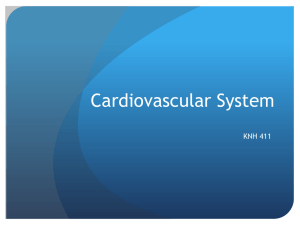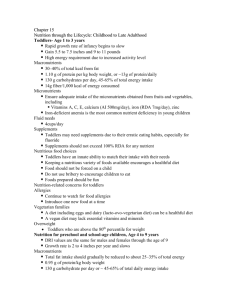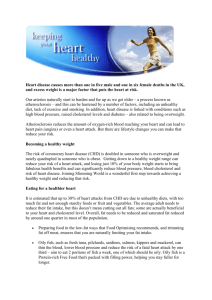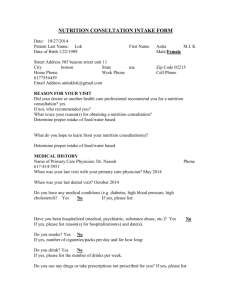Nutrition 101 – Class 6 - Logansport Memorial Hospital
advertisement
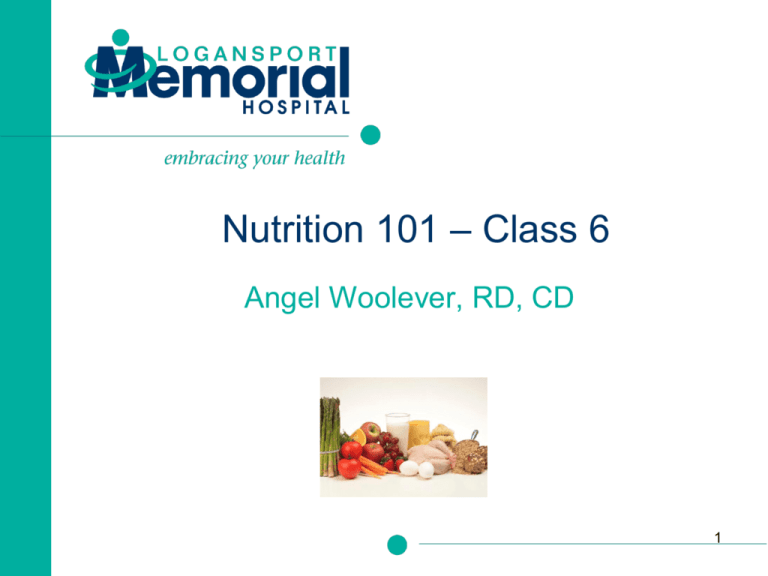
Nutrition 101 – Class 6 Angel Woolever, RD, CD 1 Computer Difficulties Contact Erin Deichman (574)753-1706 edeichman@logansportmemorial.org 2 Questions You may raise your hand and type your question All questions will be answered at the end of the webinar to save time 3 Nutrition 101 Introduction to Human Nutrition” second edition Edited by Michael J. Gibney, Susan A. Lanham-New, Aedin Cassidy, and Hester H. Vorster May be purchased online but is not required for the class. 4 Dietary Reference Standards 5 Recommended Daily Allowances (RDAs) 1941, Food and Nutrition Board of the National Research Council of the USA 1943, RDAs were published “to provide standards to serve as a goal for good nutrition” 6 Dietary Reference Intakes (DRIs) 1997, Published by the Institute of Medicine Terminology changed to re-emphasize some of the basic concepts underlying the term RDA “Recommended” Prescriptive air Concerns that consumers might see this as something that had to be met daily and met precisely “Allowance” Reinforces the perception of a prescriptive approach 7 DRI Set of nutrient reference standards Considers the distribution of nutrient requirements as well as the possibility of excess 8 DRIs Estimated Average Requirement (EAR) Recommended Daily Allowance (RDA) Adequate Intake (AI) Tolerable Upper Intake Level (UL) Estimated Energy Requirement (EER) Acceptable Macronutrient Distribution Range (AMDR) 9 DRIs 10 Estimated Average Requirement (EAR) Average daily nutrient intake that is estimated to meet the requirement of half the healthy individuals in a particular life stage and gender group Requirement is based on intake needed for a desirable level of function rather than the amount needed to prevent deficiency disease 11 Recommended Dietary Allowance (RDA) Average daily dietary nutrient intake that is sufficient to meet the nutrient requirements of nearly all healthy individuals in a particular life stage and gender group Goal for intake by individuals 12 Adequate Intake (AI) Recommended average daily intake level based on observed or experimentally determined approximations or estimates of nutrient intake by a group of apparently healthy people that are assumed to be adequate Used when an RDA cannot be determined 13 Tolerable Upper Intake Level (UL) Highest average daily nutrient intake level that is likely to pose no risk of adverse health effects to almost all individuals in the general population Does not apply to individuals being treated for nutrient deficiency 14 Estimated Energy Requirement (EER) Average dietary energy intake that is predicted to maintain energy balance in healthy adults of defined age, gender, weight, height, and level of physical activity consistent with good health May need to monitor weight to assess adequacy of energy intake 15 Acceptable Macronutrient Distribution Range (AMDR) Represents a range of intakes for a particular energy source that is associated with reduced risk of chronic disease while providing adequate intakes of essential nutrients Expressed as a percentage of total energy intake, were established for carbohydrate, protein, total fat, n-3 and n-6 fatty acids 16 Using DRIs 17 18 What to look for on a food label??? 19 Food Label Close-Up 20 Nutrition Facts Label 1-Look at the serving size and servings per container 2-Check out the total calories and fat calories 21 Nutrition Facts Label 3-Total fat and breakdown includes saturated fat and trans fat. Also listed is total cholesterol. 4-Sodium content 5-Total carbohydrate (don’t let this confuse you.) 22 Nutrition Facts Label 6-Dietary fiber and sugar content (note these are included in the total carbohydrate number.) 23 Nutrition Facts Label 7-Grams of protein per serving (note 7g of protein=1oz meat). The blue shaded area lists the Daily Value percentages of Vitamin A, Vitamin C, Calcium and Iron. 24 Nutrition Facts label 8-This last section includes the total fat, saturated fat, trans fat, cholesterol, sodium, total carbohydrate, and fiber recommendations based on 2000 and 2500 calorie diets. 25 Nutrition Claims Low Calorie 40 calories or less Fat Free Less than ½ g fat Low Fat 3 g or less Cholesterol Free Less than 2 mg cholesterol and 2 g or less saturated fat 26 Nutrition Claims Low Cholesterol 20 mg cholesterol or less and 2 g or less saturated fat Sodium Free Less than 5 mg sodium Low Sodium 140 mg or less sodium High Fiber 5 g or more fiber 27 Ingredients Ingredients are listed in descending order of weight (from most to least). 28 Comparing Ingredient Lists Plain Yogurt – contains no added sugar Ingredients: cultured pasteurized grade A nonfat milk, whey protein concentrate, pectin, carrageenan. Fruit Yogurt – contains added sugar Ingredients: cultured grade A reduced fat milk, apples, high fructose corn syrup, cinnamon, nutmeg, natural flavors, and pectin. Contains active yogurt and L. acidophilus cultures. 29 Comparing Ingredient Lists If you are concerned about your intake of sugars, make sure that added sugars are not listed as one of the first ingredients. Other names for added sugars include: corn syrup, high-fructose corn syrup, fruit juice concentrate. 30 Questions, Comments 31 Nutrition 101 – Class 6 Angel Woolever (574) 753-1462 dietitian@logansportmemorial.org 32

